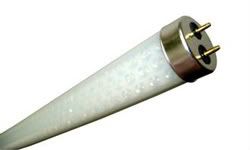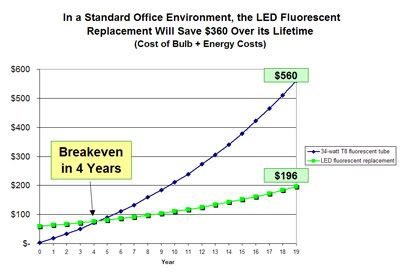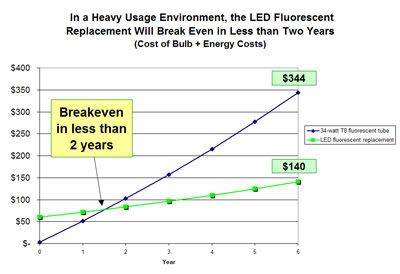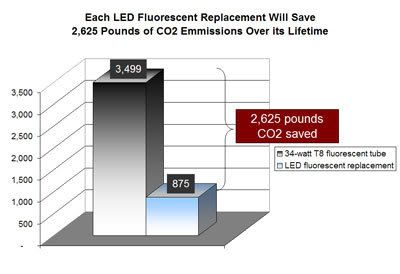I was asked to be a speaker at the Pasadena seminar series, the Art of Business Survival, which is put on by the City of Pasadena, the Pasadena Chamber of Commerce, and the Workforce Investment Board. The focus of the seminar was "What it Means to be a Green Business."
The audience was mostly small business owners in Pasadena and surrounding areas. Here's a copy of the presentation:
Tuesday, October 14, 2008
Friday, October 10, 2008
LED Lighting - Fluorescent Replacements
Sorry for the long delay in my posts, I was on vacation in the green country of Brazil... uhh... researching their sugar ethanol fuel industry. Okay okay, it had more to do with researching their fermented sugarcane, or cachaça, industry.
Today I'm going to do the math on something I've been quite excited about for a while but is now officially here: LED lighting for offices. [Disclaimer: I know it's here because our company, Go Green Solutions, is selling these]

Why am I so excited? Simply put, LEDs are the future. The ones I'm talking about specifically today are fluorescent tube replacements, which will be especially important since these tubes are almost omnipresent in our office buildings. So much so that 500-600 million fluorescent tubes are replaced each year.
OK, first let's look at the qualitative differences:
-LED lighting has no mercury. Fluorescents do, and have to be disposed of as hazardous waste
-The LED tubes we've tested use 1/4 the wattage (more on this later)
-Under LED tubes you get twice the footcandles at 6 feet!
-The LED tubes last ~6 times as long: 50,000 hours vs. 8,000
-No flicker
-No hum or buzz
-More full spectrum light. Honestly, we've set these tubes up side by side with fluorescents and it's just no contest. The LED light looks like real light. The fluorescent looks like the light they'd give you in an insane asylum.
Of course there is a hurdle: price. And it sure seems like a sizable hurdle right now. Our LED tubes are retailing for $59.95 which seems steep when compared to a cool white fluorescent that may cost $4 or $5. But let's factor in the energy costs. Our LED tube uses 10 watts. The cool white fluorescent T8 four foot tube uses 40 watts. At 10 hours a day, 260 days a year (standard office usage, assuming they turn the lights off at night) that's a difference of about 75 kWh per year, or $11 in energy costs per tube per year!
As you can see from the chart below, the bulbs will break even after four years, and over the course of their lifetime end up saving you over $360. And that's not even including the cost of labor for replacing the ~5 extra fluorescents that burned out in between, or the costs of disposing of them as hazardous waste.

That's pretty significant, and pretty much a no-brainer already. But what about locations such as supermarkets and manufacturing facilities that are running 20-24 hours per day? I did another calculation at 22 hours per day, 365 days per year. The LED tubes break even in 1.5 years.

And of course, financial considerations aren't the only ones. Each tube you replace will save 2,625 pounds of carbon dioxide emissions over its lifetime. Just imagine if instead of those 500-600 million fluorescent tubes that are bought each year, we were installing these LED tubes. That'd remove close to 14 million tons of CO2 from the air per year.

As I said, the future is here, and it's... [resists urge to say "bright"]... promising.
Today I'm going to do the math on something I've been quite excited about for a while but is now officially here: LED lighting for offices. [Disclaimer: I know it's here because our company, Go Green Solutions, is selling these]

Why am I so excited? Simply put, LEDs are the future. The ones I'm talking about specifically today are fluorescent tube replacements, which will be especially important since these tubes are almost omnipresent in our office buildings. So much so that 500-600 million fluorescent tubes are replaced each year.
OK, first let's look at the qualitative differences:
-LED lighting has no mercury. Fluorescents do, and have to be disposed of as hazardous waste
-The LED tubes we've tested use 1/4 the wattage (more on this later)
-Under LED tubes you get twice the footcandles at 6 feet!
-The LED tubes last ~6 times as long: 50,000 hours vs. 8,000
-No flicker
-No hum or buzz
-More full spectrum light. Honestly, we've set these tubes up side by side with fluorescents and it's just no contest. The LED light looks like real light. The fluorescent looks like the light they'd give you in an insane asylum.
Of course there is a hurdle: price. And it sure seems like a sizable hurdle right now. Our LED tubes are retailing for $59.95 which seems steep when compared to a cool white fluorescent that may cost $4 or $5. But let's factor in the energy costs. Our LED tube uses 10 watts. The cool white fluorescent T8 four foot tube uses 40 watts. At 10 hours a day, 260 days a year (standard office usage, assuming they turn the lights off at night) that's a difference of about 75 kWh per year, or $11 in energy costs per tube per year!
As you can see from the chart below, the bulbs will break even after four years, and over the course of their lifetime end up saving you over $360. And that's not even including the cost of labor for replacing the ~5 extra fluorescents that burned out in between, or the costs of disposing of them as hazardous waste.

That's pretty significant, and pretty much a no-brainer already. But what about locations such as supermarkets and manufacturing facilities that are running 20-24 hours per day? I did another calculation at 22 hours per day, 365 days per year. The LED tubes break even in 1.5 years.

And of course, financial considerations aren't the only ones. Each tube you replace will save 2,625 pounds of carbon dioxide emissions over its lifetime. Just imagine if instead of those 500-600 million fluorescent tubes that are bought each year, we were installing these LED tubes. That'd remove close to 14 million tons of CO2 from the air per year.

As I said, the future is here, and it's... [resists urge to say "bright"]... promising.
Subscribe to:
Comments (Atom)

